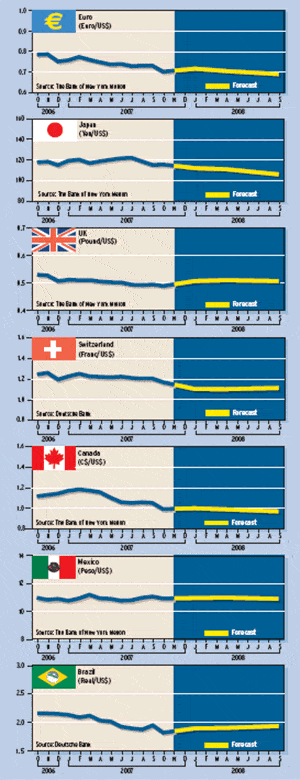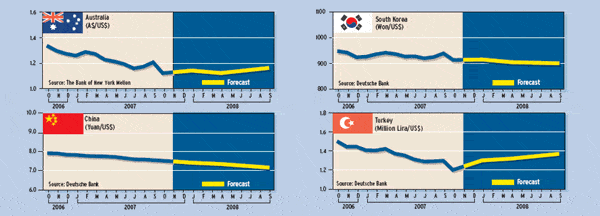 The dollar tumbled to a record low against a basket of leading currencies known as the dollar index at the end of September and likely will fall further, but no dollar crisis or rescue package is likely, analysts say.
The dollar tumbled to a record low against a basket of leading currencies known as the dollar index at the end of September and likely will fall further, but no dollar crisis or rescue package is likely, analysts say.
The dollar’s renewed slide after the Federal Reserve cut interest rates by a half point on September 18 raises questions about how low the greenback could go, says John Normand, global currency, commodity and fixed-income strategist at JPMorgan Securities in London. In a report released on September 27, the bank revised its forecast peak in the euro from $1.42 to $1.48 in the first quarter of 2008, with the dollar then expected to turn upward in anticipation of higher US rates later next year.
“Absent a relapse in the credit markets, we do not expect dollar weakness to morph into a dollar crisis characterized by a sustained rise in volatility which undermines US bonds and stocks,” Normand says. Offering some support for the dollar will be a turn in the US economic growth cycle, he says. Even in a recession, the dollar typically starts to recover six months after the recession hits, since investors anticipate an eventual improvement in growth and investment prospects, he notes.
European officials have been remarkably relaxed toward what has been a 70% appreciation in the euro in the past seven years, but this is liable to change as growth momentum in the euro region fades and inflation becomes less of a pressing policy issue, Normand says. Should the euro rise toward the $1.50 area, he says the judgment of policymakers is likely to shift from accepting euro strength as a reflection of economic vitality and as an anti-inflationary bulwark, to resisting currency appreciation as an undesirable headwind to the economy.
Analysts do not expect the dollar to be the recipient of a rescue package, however. The first rule of thumb is that dollar rescues go nowhere without the United States on board, says David Gilmore, partner and economist at Essex, Connecticut-based Foreign Exchange Analytics. “My sense is that there is not even a consensus within the Bush administration that the dollar is in trouble and needs any official help—verbal intervention or otherwise,” he says.
“As far as US officials are concerned, preemptive policy is to deny, deny, deny that the dollar is a problem in hopes of making a consensus,” Gilmore says. “When facts catch up with assertions, they respond with mantra chanting and assurances that the US economy is doing swimmingly well.”
Although a dollar rescue, unilateral or multilateral, is not in the Bush administration’s tool kit, Gilmore says, the US treasury should have contingency plans for a run on the dollar. “Assertions and denials are good poker faces, but Washington needs a strategy for a non-Hollywood ending to the weak-dollar screenplay,” he says.
Fed rate cuts were important markers for turning points in risk appetite in the 1987 and 1998 financial crises, says Binky Chadha, strategist at Deutsche Bank in New York. “There is good reason to believe that the larger-than-expected cut by the Fed [in September] is such a marker,” he says. Additional signs of weakness in the economy are likely to be met by further Fed rate cuts, which reduces the probability of recession, he notes.
The dollar’s downward trend has been in place for more than five and one-half years but still has further to run, Chadha says. While the US current account deficit has begun to narrow, it remains significant and could be more difficult to finance as a result of the bursting of the fixed-income bubble, since the predominant source of financing has been fixed-income flows, he explains. Meanwhile, the slowing in relative US growth, and the possibility that short-term rates could fall further, imply that there will be no imminent surge in fixed-income flows to the US, he says.
Currency analysts at Barclays Capital in London say they remain bearish on the dollar in the fourth quarter, despite its sharp drop in the third quarter. The US economy faces the most downside risks, they say. And given the dependence of the United States on foreign willingness to fund its current account deficit, the prospects for the dollar are bleak, the analysts add.
European economic fundamentals have never compared so favorably to those of the US at the start of Fed easing and make it less likely that European rates will be cut, according to Barclays Capital. The region’s reduced dependence on exports to the US also means that the eurozone is less vulnerable to a US slowdown, Barclays analysts say.
While a further dollar decline seems likely, the greenback’s demise is being exaggerated, and a recovery is expected late this year or early next year, says Marc Chandler, global head of currency strategy at Brown Brothers Harriman in New York. What is ailing the dollar is largely cyclical in nature, and the US is further along in the cycle, he says.
“The traditional arguments of the perma-bears place great emphasis on the US fiscal and trade deficits, but these are not the main culprits now,” Chandler says. In fact, US trade is contributing positively to growth for the first time in years, he says. The US budget deficit also is lower than anticipated as a result of strong tax revenues.
“The primary source of pressure on the dollar appears to be emanating from the interest-rate and growth differentials,” Chandler says. The Fed was bolder than expected with its 50-basis-point cut in September, and the dollar’s slide accelerated.
“The US has once again demonstrated its pro-growth stance by being the first to ease monetary policy among the major industrialized countries,” Chandler says. This could renew the attractiveness of US asset markets and direct investment, he says.
“We expect the dollar’s decline to continue for a bit longer but suspect that we have entered the latter phases of a multi-year move,” Chandler says. Over time, investors will reward the US for its pro-growth stance, and the dollar will rebound, he says.
“If the dollar’s decline is largely cyclical, as we argue, then we should anticipate that the end of the dollar’s multi-year downtrend will come either late this year or in the first part of next year,” according to Chandler.




